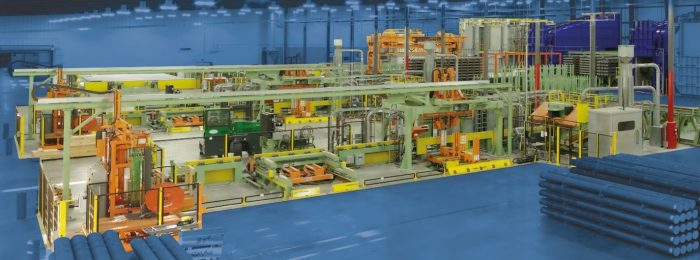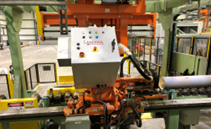Automation of billet handling: from casting to shipping

Automation is gaining territory in all sectors of an aluminium plant.
In today’s modern billet production facilities, the handling from the casting machine through to packaged billets is fully automated.
At EPIQ Machinery, our team master the flow from casting end to either shipping of packaged products or downstream to the extrusion process. Material handling for extrusion billets, including homogenizing and sawing operations. Our designs show a highly efficient automatic aluminium batch homogenizing build and break down system. Over time, our team has circled down the industry’s best practices and is sharing some insights.

Friendly-user HMI controlling each step of the process
The billet handling systems must be designed for optimal product flow, and they must not bottleneck the processing operations of casting or homogenizing. The analysis must consider these aspects:
- type of inspection required
- whether or not billets should be cropped prior to homogenizing;
- batch or continuous homogenizing;
- band saw or circular saw;
- type of marking system;
- type of stacking system;
- type of strapping material.
The product flow is as follows:
- Pit stripping, billet laydown and accumulation
- Optional inline UT inspection
- Optional head and tail cropping before homogenization
- Processing of the billets through the homogenizing process (batch or continuous type)
- Sawing of the billets to crop length only or cut-to-length
- Swarf collection and optional compacting
- Billet marking – pin or laser
- Billet stacking, strapping and packing
Each step has its own challenge and needs to be perfectly synchronized with casting area. The process starts with laying down the billets on a receiving table. After the operator releases the billets from the crane, they push a button to release them to the automatic system. All downstream operations are then completely un-manned and fully automatic.
The billets on the receiving table are gathered and “squared” with a squaring pusher. It maximizes handling and load building. The receiving table and squaring pusher are lined with ultra-high molecular weight polyethylene (UHMW) to prevent product marking.

Laydown sequence
Once the row of billets is squared, they are lowered onto the tail section of the accumulation conveyor and then advanced forward to clear the lay-down station. The squaring and accumulation are faster than the pit stripping, so the pit stripping operator never waits for the material handling system. This is an important part of the handling system strategy as the removal of billets from the casting machine is in the critical path of the casting machines throughput capabilities.
Cracks and Inclusions Detection
In the case where billets have to be inspected for cracks and inclusions, the use of Ultrasonic (UT) inspection is used. There are two choices for automatic system:

Type 2 | UT volumetric inspection system
- Type 1: Inline type which inspects for center cracks and inclusions along the full length of the billet. This is the most common for general purpose extrusion as most cracks or inclusions are found in the center of a billet;
- Type 2: Inline or offline type which inspects 100 % of the billet volume. It can be done with either conventional or phased array type probes. This type of inspection requires that the billets are rotated while the sensors are translated which results in a helical scan. Inspection time can be much longer, these types of units are often located offline and reserved for special orders which require a high level of examination, such as aerospace or other safety critical applications.
While the UT sensors maintain contact with the billet, the conveyors move the billet through the station.
If at any point during the inspection process there is a significant reflection of UT signal between the front and back wall, a flaw is detected, and the information is sent to the control system.
Crop or not to crop
Rule of thumb dictates that typically, crop cuts for billets include one diameter cut from the “butt” (beginning of cast) and one half a diameter cut from the end of the cast. Since there is a significant amount of scrap produced at cropping, the trend for billet handling systems is to remove the crops before homogenizing in order to save the cost of energy needed to heat up this metal which is to be scrapped anyway.
There are two scenarios to be considered:
A. Shipping full length cropped billets
The cropping of the billets before homogenizing would be considered best practice.
B. Cutting billets to length for the extrusion presse
A study of energy saved versus extra capital cost investment must be done and the decision to crop before homogenizing is to be taken based on the outcome of this study.
Continuous or Batch Homogenizing process
In a nutshell, here are the main differences.
Continuous homogenizing billet handling
In the case of billet handling in a continuous homogenizing system, the operation is always fully automatic. Billets are delivered one at a time to the homogenizing system and the handling through the furnace sections and cooler is achieved by way of walking beam and shuttle pick and places.
 Batch Homogenizing billet handling
Batch Homogenizing billet handling
Billets are conveyed to a layer forming station which builds a layer on top of stainless-steel spacers per pre-programmed recipes. They are automatically positioned and removed from the loads by the same automatic crane that handles the layers.

Homo load transfer car for processing the complete load
The layer forming machine staggers the logs such that they fill the airflow path in the homogenizing furnace. This optimizes the heat flow distribution for a more uniform load temperature. The charge car automatically processes the complete load through the homogenizing process by first placing it in a batch homo furnace and initiating the furnace cycle.
Sawing tailored to all sizes
Billets coming from the homogenizing process are accumulated on a conveyor which acts as a buffer between the homogenizing process and the sawing operations. In cases where billets have not been cropped before homogenizing, they are cropped at the saw and the crop cuts are delivered to a scrap bin.
The best choice of saw type depends on the diameter of billets being cut and productivity requirements. It is either a circular type or a band saw type. Typically, it is preferred to use a circular saw where there are small diameters, and the saw has to produce a very high quantity of billets per hour.
When the diameters get larger and the number of cuts per day allows, a band saw is preferable as the chip production (scrap) is much less. Other factors such as squareness of cut and surface finish often come into the discussion.
Saw chips (swarf) collection and optional compacting
Saw chips coming from the sawing operation are collected using vacuum conveying through cyclone separator. At the base of the cyclone, a rotary airlock delivers the chips either to a scrap bin or to an optional briquetting machine.


Typical process flow and photo illustration of saw chip collection
In a casthouse where a melt furnace has a side well charging port and an electromagnetic stirrer, loose chips can be directly loaded and re-melted with a very high recovery rate.
Otherwise, the chips must be compacted to be able to achieve a good re-melt recovery. Saw chips (swarf) loaded loose directly into a conventional reverb type melt furnace will burn up resulting in poor metal recovery.
Marking for Traceability and Quality control
For quality control and product traceability purposes, each cut billet which is destined for customer or downstream extrusion process is usually marked with the cast number and alloy number as a minimum.
Pneumatic punch / impact hammer type
This type has die set characters which are positioned in a die face manually. It is up to the saw operator to replace these characters with each change of cast number or alloy number. The marking devices are mounted in the billet length gauge such that the marking operation happens during the cutting cycle. Low cost and simple solution, it relies on the rigor and discipline of the operator.
Programmable pin stamper
This one is completely automatic and communicates directly with the billet handling control system. It removes probabilities of operator error. It does need frequent maintenance and replacement of parts so there is normally a back-up stamper required.
Programable laser marking
This operates similar to the pin marking type but rather than using little pins for engraving a laser with etch the surface of the cut face. The advantage to this type of marking is that it allows for more traceability. A QR code can be generated, and this data can be given to the end user for re-reading of the product. Depending on the data given it can go back to the casting data of the aluminium. The producer can also etch their company logo on the material if they choose to.


Laser marking device and results
Stack. Strap. Pack.

Automatic Billet Strapping station
Cut billets are then conveyed to the stacking and packing part of the handling system. Billet handling systems can be configured to perform one, two or all three of the following tasks depending upon the requirements of the production facility:
- Stack cut to length billets into racks which are used to store billets for in-house extrusion use;
- Stack and strap cut to length billets for storage or shipment to customers; and
- Form layers and strap long (end cropped) billets.
In conclusion, one advantage EPIQ Machinery has over competition is the gantry system for the homogenizing load build and break down area that does not touch the aluminium billets, we handle the product by the spacers. Plus, all motions during the transfer of the extrusion billets are made in linear motions, which improves the reliably and positioning of the billet at the transfer point.
Down the line, the selected solution should ensure:
- Uniform load growth during the homogenizing cycles
- Linear motions for aluminum billet transfer – no log rolling
- Robust billet homogenizing furnace spacers to prevent loads from shifting
Making the proper choices and using the latest technologies in extrusion billet handling will ensure a highly productive, safe and reliable production facility.
Author: Marty DeGoey, Senior Application Engineer